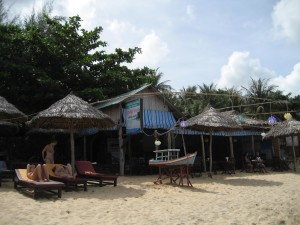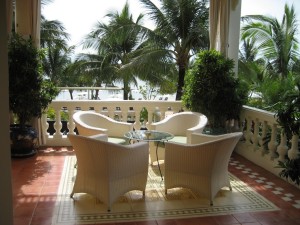
 I’ve missed a few chances over the years to be in the first wave of travelers to “discover” a place before the hordes arrive. In the 70’s I had a ticket to Bali but decided to trek in Nepal instead.
I’ve missed a few chances over the years to be in the first wave of travelers to “discover” a place before the hordes arrive. In the 70’s I had a ticket to Bali but decided to trek in Nepal instead.
Nepal was amazing but I felt I had missed its “undiscovered” phase. Others had been there when it was even less civilized. As it turns out I’m glad I chose Nepal. For 23 days a friend and I walked from Pokhara to the Tibetan border, from Mansalu and Dhaulagiri to the Mustang area. It was unspoiled and the only other Westerner we saw in those 23 days was a German woman I knew from Berlin. But, I’m a beach rat and I always regretted not seeing Bali, Goa, and the Seychelles in those days.
Last week we took four days off to visit Phu Quoc the largest of the Vietnamese islands. It’s a 40 minute flight south from Ho Chi Minh City on Air Mekong, which as a matter of interest and security contracts with Delta’s commuter airline SkyWest for its cockpit crews. All of Vietnam’s islands have been subjects of territorial dispute. Phu Quoc is no exception. It lies just 12km south of Cambodia in the Gulf of Thailand. Cambodia claimed it. The French colonized it, and Vietnamese fishermen and farmers settled it. It’s physically closer to Cambodia than it is to Vietnam but in the French, Cambodian, Vietnamese tug of wars it ended up under Vietnamese control – mostly because the Vietnamese settlers had a numerical advantage. Until tourism started to gel it was known for pepper and fish sauce. It’s local fame comes from the its reputation as the source of the Vietnam’s finest fish sauce, that ubiquitous add-on made from anchovies and served with almost everything from pork to pizza. Those two products are still important but tourism is overtaking them in importance to the local economy.
During the various wars that raged in the 20th Century a small island off the south tip of Phu Quoc housed a notorious prison. It was not as infamous as the tiger cage prison on the island of Con Dao, but the treatment of prisoners was the same. During the “American War” the prison’s inmates were Viet Cong insurgents and supporters of Ho Chi Minh.
Phu Quoc has now been discovered. It’s a favorite destination for people living in Vietnam and it’s drawing more and more European travelers. Washington State’s Governor, Christine Gregoire, stayed here after her trade mission to Vietnam in 2010 but most Americans still haven’t found it. We only saw one other American couple during our stay. What is cool is that the island is very much like Bali and Goa were 30 or 40 years ago. There are a couple of luxury resorts. La Veranda (the second photo) is only 5 years old, but it is built in the style of the French Colonial villas of the past. I felt like we were stepping back in time. Graham Greene would have been comfortable with a G&T at the bar. But, if you step out onto the beach and walk 100′ in either direction you find another less luxurious but very vibrant island. You can still find a bungalow for $20-30. You can eat fresh seafood and quaff a frosty Tiger at a rickety wooden table on the sand. You can be massaged for an hour in the sun for $4 or get a manicure for $2. Sure, the hygiene standards might not include auto-claved instruments but the experience can’t be found many other places these days. The water is clear and it’s hotter than hell. This is April and Phu Quoc is 10 degrees north of the equator. We’re nearing the end of the dry season and you can almost feel the approaching rainy season. I love the sun but even I can’t take more than a few minutes of direct sun. It’s a scorcher. Great for afternoon naps in the tile-floored rooms with ceiling fans and mosquito nets (La Veranda has A/C; Goa didn’t).
We have stayed in eleven Vietnamese beach resorts over the last 5 year. Phu Quoc is one that I would happily revisit. I didn’t discover it, but I like to think I got to see it before it became wall to wall luxury hotels like China Beach.
































